Introduction
This article takes up a series of strange, interrelated iron door locks found on a large number of buildings in a fairly limited area of Sweden. Much of my information is based on two articles written by ethnologists Sigurd Erixon and Olle Homman, printed in the 1942 edition of the Royal Gustavus Adolphus Academy for Ethnology yearbook, Folk-liv.
These pull locks were manufactured by many smiths in the Lima parish of western Dalarna Province. The locks can be divided into two main groups, dating from the first half of the 17th century to the end of the 18th. Peddlers carried them across the region, selling them in large parts of the provinces of Dalarna, Härjedalen, Hälsingland and northern Värmland. They were even sold across the border in Norway, where this type of lock is still preserved. However, there are no examples in Finland.
These pull locks were mainly used to protect provision sheds, larders and lofts, which is where the farm’s most valuable possessions were kept – its stores of food, grain and sometimes clothing. Other farm buildings had no locks at this time. The most common type of pull locks have an elongated shape, sometimes signed and decorated with etchings and rounded embossments. The locks remained in use in their limited area until the end of the 18th century – demonstrating an unusual attachment to tradition.
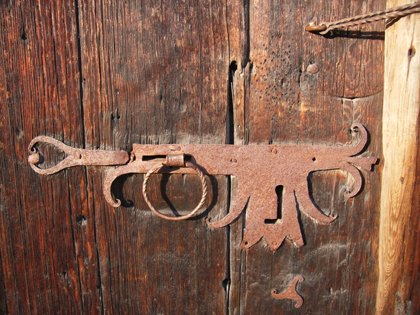 |
| Pull lock on the Bergkarlås barn in artist Anders Zorn’s collection of buildings at Gammelgård, Mora, Dalarna. Note the hint of dragon’s heads on the spiraled pull ring. Photo by the author. |
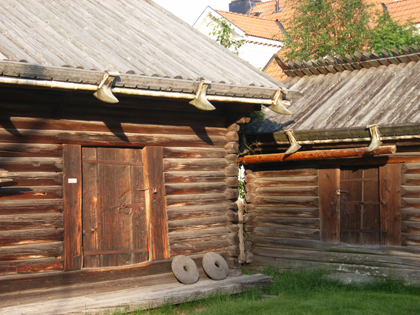 |
| Pull lock on the Bergkarlås barn and shed from Nusnäs in artist Anders Zorn’s collection of buildings at Gammelgård, Mora, Dalarna. Photos by the author. |
The mechanism of a pull lock
Ethnologist and professor Sigurd Erixon wrote an article on pull locks in the 1942 Folk-liv yearbook (see below). He divided pull locks into two main groups, divided and combined. The difference is in the mechanisms.
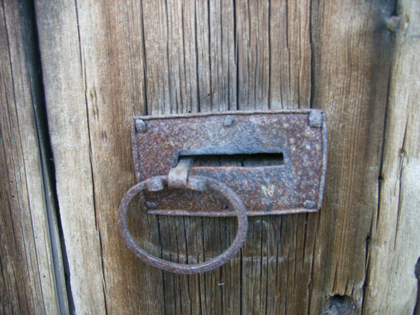 |
| Pull-lock ring on a loft building with shed from Nusnäs in artist Anders Zorn’s collection of buildings at Gammelgård, Mora, Dalarna. Note the hint of dragon’s heads on the spiraled pull ring. Photo by the author. |
The locks developed over many years, with many changes in design and decoration. Combined pull locks were made completely of iron. In their oldest shape, they consist of three ward springs, which were later expanded to four in the latter half of the 17th century, a box of wards with obstructions, and a key. To open the lock, you maneuver the key with one hand while drawing the bar using the pull ring (hence the name ”pull lock”). Like the most common door locks in Sweden in the period, tumbler locks, pull locks have a mechanism that keeps the bolt in locked position. In this case, the mechanism is a spring made up of several narrow springs, which fall down onto a small projection on the bolt when the bolt is shot. These springs must all be lifted by the teeth on the key’s bit before the bolt can be drawn. Tumbler locks, in contrast, have a single detainer, the tumbler, instead of multiple springs. The key bit lifts the detainer, and the turn of the key draws the bolt.
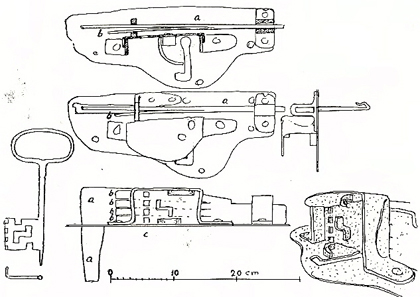 |
Iron pull lock with four ward springs, box of wards with
obstructions, and key. Sketch in "Låset förr och nu". |
A requirement for locksmithing was that iron was manufactured locally using small, primitive blast furnaces. The farmers made malleable iron themselves using bog ore and charcoal. In a travel account from 1757, Abraham Hülpher described how common this primitive production of wrought iron was.
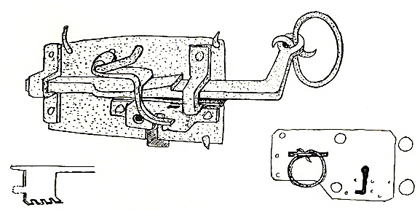 |
| A short version of a pull lock. Sketch in "Låset förr och nu". |
Pull locks probably developed from earlier and contemporary lock types with pin tumblers or pull bolts with springs. There is also a small number of pull locks with both pin tumblers and springs, and at least one case of a pull lock with only one spring and a key with only one corresponding tooth. In older pull locks, the mechanism was built into a wooden lock body, in a split woodstock. From the end of the 16th century, however, locks made wholly of iron were most common, except in Ovansiljan, which clung to the wooden variety.
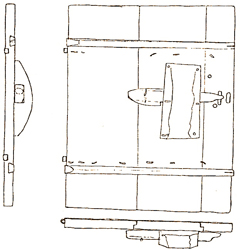 |
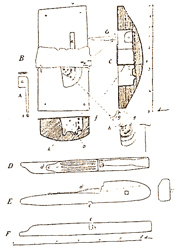 |
| Pull lock with the mechanism built into a half woodstock. A door to a sleeping loft from the late Middle Ages in Idbäck, parish of Malung, Dalarna. Sketch in Folk-liv 1942. |
The keys to pull locks have tooth-like protrusions on the bit, corresponding to the number of ward springs in the lock. Viking-Era keys have also been known to have such teeth. The pipe of the key is always uniform and ends with a tip that guides the key with the aid of a hole in the bottom of the box of wards.
Pull rings or ring handles for pull locks are usually simple rings of wrought iron, smooth or spiraled. Ring handles were common from the Middle Ages on. Even today, medieval Swedish church doors often have smooth wrought-iron door rings, sometimes with dragon heads biting fast at the top, or a simple profiled ring. The rings for pull locks can also have dragon heads, but heavily stylized.
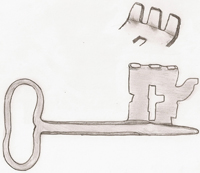 |
 |
 |
| Key to a pull lock. Sketch by the author. |
Key to a pull lock. Sketch: Erixon, "Låset förr och nu". |
Viking-Era key. Sketch by author. |